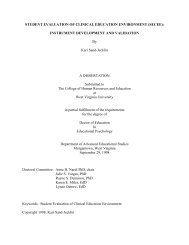Coach and Athlete Burnout - West Virginia University
Coach and Athlete Burnout - West Virginia University
Coach and Athlete Burnout - West Virginia University
You also want an ePaper? Increase the reach of your titles
YUMPU automatically turns print PDFs into web optimized ePapers that Google loves.
<strong>Burnout</strong> 4<br />
& Doherty, 1998). These latter two dimensions are of particular interest for the current<br />
study as one style of decision-making may predispose athletes to experience burnout<br />
while the other has been found to predispose coaches towards burnout (e.g. Dale &<br />
Weinberg, 1989; Price & Weiss, 2000; Vealey et al., 1998). As stated previously,<br />
research investigating the influence of leadership behaviors on coach <strong>and</strong> athlete burnout<br />
has been somewhat scarce, particularly as it relates to the moderating effects of coaches’<br />
decision-making behaviors. However, related research has focused on coach <strong>and</strong> athlete<br />
leadership preferences <strong>and</strong> satisfaction as a result of varying coach behaviors.<br />
Using the multidimensional model <strong>and</strong> dimensions of the LSS as a guide, several<br />
studies have examined athlete <strong>and</strong> coach preferences of various leadership behaviors.<br />
For example, Chelladurai <strong>and</strong> Saleh (1978) found that athletes in team sports preferred<br />
greater coaching behaviors emphasizing training than those in individual sports. Further,<br />
males were found to prefer social support more than females. Chelladurai <strong>and</strong> Carron<br />
(1983) also studied these two coaching behaviors. Their investigation assessed if<br />
preferences for social support <strong>and</strong> training <strong>and</strong> instruction varied as a function of athletic<br />
maturity. Their results indicated that training <strong>and</strong> instruction preferences decreased<br />
throughout high school but increased at the university level. Preferences for social<br />
support increased from early high school to the university level of athletics.<br />
Research Regarding Decision-Making Style in Sport<br />
<strong>Athlete</strong> preferences of decision-making styles have also been addressed in the<br />
leadership literature. In this line of research, several styles of decision-making have been<br />
identified. For example, although not developed in a sport context, Vroom <strong>and</strong> Yetton<br />
(1973) presented a continuum of styles ranging from autocratic to group, where












